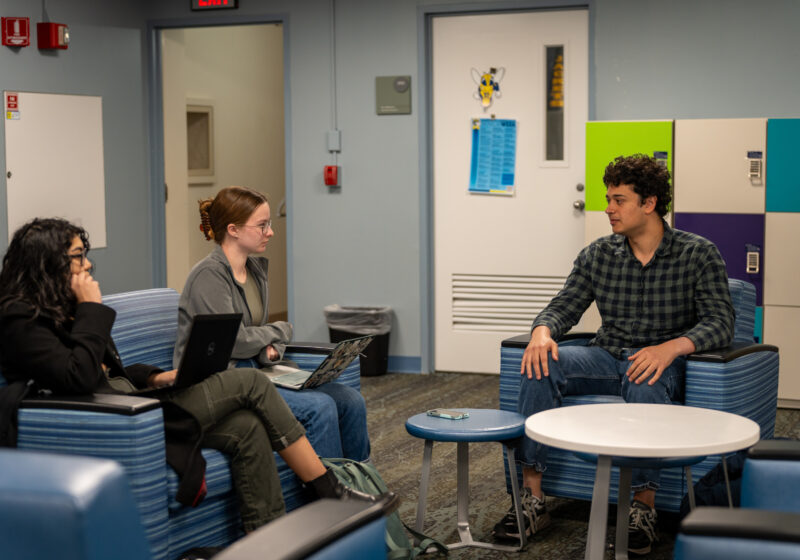“Back in the day,” Dennis O’Donnell began, “The person you chose to run the scorebook was whoever had the sharpest pencil.” Spoken amidst the clutter of computers and gadgets in the Athletic Communications office, O’Donnell’s statement seems comically out of place.
As Director of Athletic Communications at the University of Rochester, O’Donnell is no stranger to the sweeping changes technology is making to athletics. He is the face behind the published scores and game recaps found on the university website. When asked about the impact of technology in the athletic world, a recent game came to mind.
“If you go back to this past Super Bowl, Sunday, Feb. 7, we missed a free-throw intentionally at the end of the game. As soon it happened, we immediately took the video clip of the trick-shot, tweeted it out, and let ESPN know about the play”, O’Donnell explains. Within the next day, the video went viral. “If it wasn’t for technology, all I would have been able to do was write a report stating that one of the players made a trick-shot to win the game. Now people can see it with their own eyes.”
Beyond the obvious growth of media outlets and mediums, the emergent role of technology in athletics is heavily represented in varsity sports on campus. Each year, more and more coaches turn their attention to finding the defining developments in their field, and each year, technology is what’s making the difference.
“The coaches are constantly searching for the very best software and technological equipment,” says Andrea Golden, Associate Director of Athletics. “We are looking for things that allow athletes to fine-tune their performance, and are not too cost-prohibitive.”
The Varsity Rowing team is just one of several sports that have begun to incorporate technology into their training. With the recent purchase of SpeedCoach GPS, they can monitor stroke rate, speed, time, and distance from each boat on the water. The SpeedCoach allows for the coaches to obtain “the same data for on-the-water workouts, as we have had from indoor training”, said Heather Goerlich, Assistant Coach for Women’s Rowing.
“The SpeedCoach makes us work harder and is useful in comparing how we work on an erg versus how we work in a boat. That way, the coxswain has proof of when we slow down during a race, or when we start to lose power”, said sophomore Mattison Flakus. “After a race, you can look back to see what improvements can be made to the race plan.”
Another way technology has significantly impacted practice methods for the rowing team is through video analysis and editing. They film practices with smartphone apps that allow them to zoom in and focus on each athlete individually, marking and monitoring the angles of their motions while they row. “It’s actually really helpful”, said Flakus, “When the video is put in slow motion, it allows you to see the exact moment your oar goes into the water.”
The rowing team is one of many teams using video analysis to monitor their practice and performance. “We use an iPad to record practices and show videos back to the girls so they can see how they’re doing,” said Marissa King, Assistant Coach for Women’s Varsity Volleyball, and they’re not the only ones. For the Varsity Men’s and Women’s Basketball teams, video editing and breakdown is an essential part of how they function.
“Most of our technology is used for scouting. We get to know how our opponents play, before each game”, said Amy Woods, an Assistant Coach to the Women’s Basketball team. “Everyone in our conference uses Synergy Sports, a film-sharing website. Every team has to upload videos of their games so that everyone has access to it.”
“You could look up any player in the league and learn what they’re shooting like”, Kaitlin Donahoe, another Assistant Coach for the Women’s team, said. “You could learn every possible offensive move your opponent might make. It’ll even give you shot charts so that you can see where they’re most effective.”
Athletic areas that have the most significant growth in technological development are programs related to strength and conditioning. Women’s Soccer has begun to use Polar Watches for training, while Women’s Lacrosse now uses a conditioning program called Volt. “The areas that people are adding to are primarily based on personal training,” Golden said. We’re moving towards a world where the individual athlete is able to explicitly measure their abilities and improvement rates.”
Varsity Golf is one team whose new technology has the potential to dramatically change the way their individual athletes are analyzed. “It’s called a Foresight gc2,” said Dan Wesley, Head Coach of the Men’s Golf team. “It’s a high speed camera that captures the impact of the golf club making contact with the golf ball and the data that goes with it.”
This cutting-edge camera reports the rpms of the ball’s backspin, the distance it flew in yards, how far left or right it moved in the air, and the amount of compression the ball experiences against the club. “It’s a big help for us. When we are hitting balls in the Fieldhouse, the ball can only go thirty yards before hitting the net. With this camera, we can see how far it would have gone on the course.”
Last March, when the athletes travelled to Florida for spring break, Wesley found that his athletes had a better idea of where they stood from the start, having been able to follow their progress with the camera through the winter. “I would say that it is a nice addition for our team,” said senior George VanderZwaag. “It changes the way we practice during the winter.”
There’s no doubt that technology has had a significant impact on the practices and performance of athletics on campus. Technology is constantly evolving and is a shaping force in the development of athletics today. But when asked whether keeping up with athletic tech and trends was a focus for the university’s athletic department, the response was a resounding “No.”
“At big time Division I schools that have a bunch of money to throw around, they have technology like underwater cameras they can use to videotape and analyze the force and velocity throughout a stroke,” Emily Wylam, Head Coach for Men’s & Women’s Varsity Swimming, said. “But the clock is all we need.”
“It’s just an accessory,” Golden argued. “It’s an accessory that we hope helps to raise our level and allow us to fine-tune athletic skills, but fundamentally, our focus remains grounded in finding the ways to best encourage students to learn the skills, understand the strategies, and dedicate the time to get the most they can out of practice each day.”

